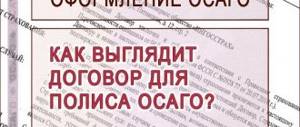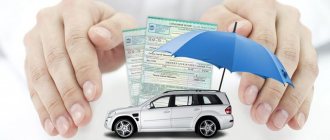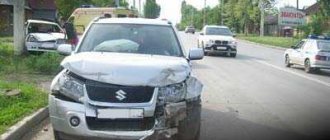How to file a traffic accident?
If the following conditions are met, then the accident can be registered using a European protocol:
- damage in the accident was caused only to vehicles and there were two of these vehicles,
- both drivers agree with the circumstances of the accident and the list of visible damage to the cars,
- there were no injuries or fatalities in the incident,
- The liability of both drivers is insured under MTPL (there are valid MTPL policies).
To do this, it is necessary to fill out the notice together, with each driver signing both sheets of the notice on the front side. Each of the participants in the accident fills out the back side themselves.
If at least one of the above conditions is not met, if there are victims or damage to other property is caused, then traffic police officers must handle the registration of the accident. They record all the circumstances and issue documents with which the victim will go to the insurance company.
Sometimes so-called emergency commissioners arrive at road accidents. These are not traffic police officers and they do not have the right to register an accident, but there is apparently some kind of agreement between the traffic police officers and these commissioners, so the latter record the circumstances and then transfer the materials to the traffic police.
You can entrust the registration to emergency commissioners only at your own peril and risk... If, when registering an accident, they indicate something or do something incorrectly, there will be no one to ask.
Likewise, if they lose or do not transfer the material to the traffic police, then registering the accident again will be extremely problematic, sometimes even impossible. Sometimes commissioners are not shy about demanding money for their work, so decide for yourself in advance whether, in the event of an accident, you will trust them or insist on the arrival of police officers.
Payments under compulsory motor liability insurance if the driver was drunk during the accident
If the injured driver is involved in a traffic accident and it turns out that he was intoxicated, this entails serious consequences. But this fact in itself does not affect the fulfillment of obligations by the insurance company.
If the at-fault driver was intoxicated, his insurance company will in any case compensate for the damage caused to other participants in the accident. But then she can initiate a recourse process and, through the court, demand a refund of the amount paid. This means that if the driver drank, got behind the wheel and caused an accident, he needs to prepare money to cover the damage.
How long the insurance company pays under compulsory motor liability insurance does not depend on whether a driver was intoxicated or not. This point can only affect the process of collecting documents and issuing certificates.
What documents are needed to apply for compulsory motor liability insurance?
The set of documents for the insurance company will depend on what kind of accident there was and how it was processed.
A complete list of them in case of damage to the property of victims is indicated in clause 3.10 and clause 4.13 of the Insurance Rules. The victim whose accident was registered according to the European protocol will have the most minimal set. This:
- application for payment
- accident notification,
- passport of the beneficiary (owner) of the car,
- as well as documents confirming ownership of the car (most often an STS is suitable, but formally this is a purchase and sale agreement).
Those victims whose accidents were registered by police officers will also have to provide:
- a copy of the administrative violation protocol,
- resolutions in a case of an administrative offense or rulings on the refusal to initiate a case of an administrative offense.
And those who were injured in an accident and their health was harmed are forced to collect the largest set of documents, since it will be necessary to provide medical documents:
- certificates from a medical organization,
- conclusion of a forensic medical examination,
- documents in case of loss of earnings and in some cases other documents.
A complete list of these documents can be found in Chapter 4 of the Insurance Rules.
How are 20 days for payment calculated correctly?
It is correct to consider the payment period to be 20 days after the date of acceptance by the insurance company of the application for payment with all the necessary documents. What do public holidays mean? These are those holidays that are considered officially non-working days off. But ordinary Saturday and Sunday do not fall under these dates.
Let's look at an example! In our example, official non-working holidays are considered to be 1, 2, 3 and 8, 9, 10 May 2021. You are a victim of an accident and submitted an application with all the necessary documents on April 25, 2021. This means that you will receive the payment by May 21, 2021. That is, the numbers that are included in the 20 days required by law are April 26, 27, 28, 29, 30, 4, 5, 6, 7, 11, 12, 13, 14, 15, 16, 17, 18, 19 , May 20, 21. And on May 22, the insurance company will begin to delay payments under compulsory motor liability insurance.
It should be noted that insurance companies often like to talk about the start of the period of 20 days only after inspection or examination of the damaged car. This is illegal, since the quote from the law above calculates this period from the date of filing the application with a set of documents about the accident to the insurance company. Another common case is when insurers talk about 20 working days - this is also illegal, since the article provides for calendar days, except for non-working holidays.
What is the deadline for applying for payment?
In the Law on Compulsory Motor Liability Insurance, current for 2021, the deadline for filing an application is specified only for the case of registration of an accident under the European protocol - as soon as possible, but no later than five working days after registration of the accident. But violation of this deadline cannot be the reason for refusal of insurance compensation. Therefore, we can say that in general, the period for contacting an insurance company is not strictly regulated.
You should rely only on the statute of limitations, which will begin to count from 21 days after contacting the insurance company with a full set of documents, and which is 3 years.
And in cases of harm to the life and health of the victim, there is no statute of limitations for contacting the insurer under compulsory motor liability insurance.
According to Art. 208 of the Civil Code of the Russian Federation, the statute of limitations does not apply to claims for compensation for harm caused to the life or health of a citizen.
But all of the above is rather applicable in some exceptional cases, because each of us will try to receive compensation for damage as quickly as possible, because even by contacting the insurer as soon as possible, you can wait for payment for a year or even more, but we will talk about this further .
Reasons for delay
Many car owners have claims when payments are delayed, but few ask themselves whether all the documents have been submitted and when they were received by the insurance company.
If someone was injured in a traffic accident, the time required to collect documents will increase. Investigative authorities are involved in the investigation of this event; in this case, certificates describing the incident in full are issued after a month or two, and sometimes more. These documents contain a fairly large amount of information necessary for the insurance company to confirm that the policyholder was sober at the time of driving the vehicle, that he had a driver’s license at the time of the accident, etc.
All this information is contained in documents that employees of the competent authorities can issue for quite a long time. Therefore, if your insurance payments are delayed, contact your insurance company and find out the reason. Perhaps you simply forgot to submit some document or there is an error in the documents.
It follows from this that the period actually allotted for the consideration of the application by the insurance company of the case will begin only after all errors have been corrected or missing documents have been submitted.
Can I contact my insurance company?
You can not only contact your insurance company, but, more often than not, you even need to contact them exclusively. Based on the number and nature of accidents that occur in our country, most often they meet the requirements for direct compensation for losses.
The victim makes a claim for compensation for damage caused to his property to the insurer who insured the civil liability of the victim, if the following circumstances exist simultaneously:
- a) as a result of a traffic accident, damage was caused only to the vehicles specified in subparagraph “b” of this paragraph;
- b) a traffic accident occurred as a result of the interaction (collision) of two or more vehicles (including vehicles with trailers), the civil liability of the owners of which is insured in accordance with this Federal Law.
In other cases, you should contact the culprit's insurer. And in some cases, victims have to apply to the RSA for compensation.
What to do if your payment was refused or you paid little?
It is possible to sound the alarm already 21 days after the day of submitting the full set of documents to the insurer, but it is not entirely correct. The insurer has every right to send you a referral for repairs in a simple letter, via mail, and doing this on the 19th day of the term will not violate anything. Therefore, it is best to wait at least 7 days, in case a letter was sent to you, and only then start a dispute with the insurer.
Before calling, writing or going to the insurer, we strongly recommend that you carefully read and study the following materials: Article 16.1 of the Law on Compulsory Motor Liability Insurance and our article about the financial ombudsman.
Do not forget that compulsory motor liability insurance currently represents “partial insurance”, that is, even if the insurer calculates and evaluates everything correctly, the payment made to you or the service station may not be enough for repairs. In this case, the remaining damage must be recovered from the culprit of the accident.
When the insurance company refuses to pay
In essence, car insurance is a way to reduce probable financial losses in case of unforeseen circumstances. But sometimes compensation for damage under compulsory motor liability insurance completely depends on the actions of the policyholders themselves. So, what should you avoid in order not to lose legitimate insurance compensation?
The culprit in the accident
As a general rule, only persons who are not at fault for an accident receive insurance compensation. However, in practice, sometimes very ambiguous situations arise. For example, if an incident involves not two, but more vehicles, and a particular driver is both the victim and the culprit. That is, another participant in the accident also committed a traffic violation against him. In this situation, payment is due not only to the injured party, but also to the guilty party. Most often, such cases are resolved in court.
If the perpetrator of a traffic accident dies, his relatives do not receive funeral payments. The only exceptions are situations where a pedestrian dies who caused an accident - his relatives receive payments under compulsory motor liability insurance. As practice shows, vehicle drivers are most often found guilty, despite how the collision actually occurred.
Another nuance. If it is impossible to establish the guilt of a specific driver insured under compulsory motor liability insurance, then the second participant cannot receive compensation. According to the Law on Compulsory Motor Liability Insurance, there must be a culprit in an accident, then there will be a victim. In order to defend his right to payment, the injured policyholder must order an additional examination. If this does not produce results, you must go to court. If the second participant is insured under CASCO, then carry out additional insurance. There is no need for an examination, the insurance company will compensate for the damage anyway.
If the fault in the incident is mutual, then the degree of guilt of each of the participants is determined in court. For example, when it turns out that the drivers are equally guilty, then each will receive only 50% of the actual amount of damage.
Lack of compulsory motor liability insurance policy
If there is no insurance, then there is no insurance company that is obliged to compensate the injured person for the damage. This is very unpleasant for the driver, but nothing can be done about it. The situation is similar if the harm-doer has a compulsory motor liability insurance policy in his hands, but it has expired. As in the first case, there is no insurer obligated to cover losses to the injured car owner.
Let's consider another situation. The owner of the car that was involved in the accident has insurance with a list of persons allowed to drive the car, but it does not include the name of the citizen who caused the accident. In this case, the injured driver has the right to receive insurance compensation, but then it will be claimed by the Insurance Company from the culprit.
The accident occurred abroad
Compulsory and voluntary insurance policies are valid only in the territory of the country in which they were received, that is, in Russia. When planning a foreign car trip, you must purchase a special policy - a Green Card. It is this that will allow you to receive insurance compensation in the event of an insured event abroad.
Incomplete package of documents
The insurer is obliged to pay the insured the due insurance premium only if the full package of documents is submitted in a timely manner. Therefore, as soon as you have a certificate of an accident in your hands (please note that since October 20, 2017 it has been canceled and you need to get another document to replace it), a decision to initiate or refuse to initiate a criminal case, immediately go to the Investigative Committee and fill out an application . You should attach all the documents you currently have. If necessary, the remaining papers can be delivered later. This way, you will not exceed the statutory deadline for submitting documents – 5 days.
If the accident is registered according to a simplified scheme, then the insured also has only 5 days to submit an application to the insurance company (to his company). Fortunately, when drawing up the Europrotocol, the injured person must only submit an application for payment and a notice drawn up and signed by both parties.
The vehicle was not provided for inspection
Clause 20 Art. 12 of the Federal Law “On Compulsory Motor Liability Insurance” allows insurers not to compensate for damage to policyholders who did not provide a damaged car for inspection at the agreed place and time.
If the policyholder did not do this, or restored the car before the damage was assessed, or disposed of it, then he has no right to count on insurance compensation.
On-site calculation
If the drivers agreed on the amount of compensation without involving traffic police officers, then in the future you cannot count on any money from the insurance company, even if it turns out that the amount received is not enough to fully restore the car. Firstly, you will not have documents about the incident. Secondly, you cannot receive money twice for the same case (first from the guilty party, then from the insurer).
The party transferring the money must obtain a receipt from the recipient confirming that the cash has been accepted and that there are no claims against him in the future, even if hidden defects are discovered in the car. In general, it is better not to resort to this method, since after some time the victim may contact the traffic police and report that you illegally left the scene of the accident.
Alcohol intoxication
If the culprit was drunk at the time of the collision, his insurance company will still pay the victim the compensation due, but will then require the culprit to compensate him. If the victim turns out to be drunk, then the situation is somewhat different. Firstly, this fact still needs to be proven.
Its reflection in a certificate of an accident based on the results of a “national examination” called “blow into a tube” is not enough. In order to refuse payment, the insurer must rely on the results of a medical examination.
Secondly, most often such cases are considered in court. It is there that the degree of guilt of each of the participants in the event is determined. If it is determined that the tortfeasor is 60% to blame, and the drunken victim is 40% at fault, then the first will be paid only 40% of the damage, and the second – 60%.
Fraudulent schemes
If during the trial the car owners are convicted of fraud, you can forget about any payments. If the insured who is innocent of the accident is confident in his integrity and believes that the insurance company is simply trying to evade its obligations, he must go to court and defend his right to insurance compensation.
Bankruptcy of the insurance company
Such cases are not at all uncommon in Russian reality. Therefore, before signing an insurance contract, make sure that the company is reliable. This is not difficult to do - there is publicly available information on the Internet regarding reliability ratings, financial solvency, percentage of insurance cases being considered in court, etc.
But if, nevertheless, an insured event occurred, and the insurance company declared itself bankrupt or was deprived of its license, you should prepare a package of documents and send it to the RSA. It is this organization that is responsible for the MTPL obligations of bankrupt companies.
This rule does not apply to CASCO insurance - receiving payment under a voluntary policy from RSA is much more problematic than under a mandatory one.
Availability of accident insurance
If persons injured in an accident have a CASCO policy that insures against road accidents in transport, the insurance company has the right to refuse compensation under compulsory motor liability insurance, since it is under accident insurance that the insured will receive payment.
Will I receive a payment or repair?
In 2021, for individuals whose vehicle is registered in the Russian Federation, priority has been established for in-kind compensation for damage (repairs at a service station) rather than payment of the cost of restoration repairs in cash.
But there are exceptions in which the insurer is obliged to pay in cash. This happens in the following cases:
- complete loss of the vehicle;
- death of the victim;
- causing serious or moderate harm to the health of the victim as a result of an insured event (must be indicated separately in the application);
- if the victim is a disabled person specified in paragraph one of paragraph 1 of Article 17 of the Law on Compulsory Motor Liability Insurance (must be indicated separately in the application);
- if the cost of restoration repairs exceeds the limits of 400,000 and 100,000 rubles, depending on the method of registering the accident;
- if, in accordance with paragraph 22 of the Law on Compulsory Motor Liability Insurance, the fault is recognized as mutual, and the participants in the accident do not agree to pay extra at the car service center;
- if the car service does not meet the requirements for repairing your car (for example, the insurance company does not have contracts with official dealers, and your car is less than 2 years old);
- if the insurer cannot organize repairs at the station that the victim chose when concluding the MTPL contract and the victim does not agree to have the car repaired at another station;
- existence of a written agreement between the insurer and the victim (beneficiary).
Read more about the choice between payment and repair in our previous article: Repair or money: who chooses, the insurance company or the car owner, and which is better?
The limit under the European protocol is 100 thousand (conditionally 400)
The notification is a simplified way of registering an accident without calling the traffic police. It is logical that the insurance market in this situation is concerned with protecting itself. Therefore, the maximum payment amount under the European protocol is 100,000 rubles. This is dictated by paragraph 4 of Article 11.1 of the Federal Law on Compulsory Motor Liability Insurance:
4. In the case of registration of documents about a traffic accident without the participation of authorized police officers, the amount of insurance compensation due to the victim for compensation for damage caused to his vehicle cannot exceed 100 thousand rubles, with the exception of cases of registration of documents about a traffic accident incident in the manner provided for in paragraph 5 of this article.
Please also note that the culprit of the accident, when registering with a European protocol, is obliged to notify his insurance company about the event with evidence of such notification within 5 working days, and also not to repair or dispose of the car for 15 calendar days. Otherwise there will be regression.
From the provisions of the above rule of law, it can be noted that there are exceptions to this general rule. Let's take a closer look at it!
In what cases is 400,000?
Briefly speaking, to be able to receive up to 400 thousand via the European protocol, 2 (both at the same time) indispensable conditions must be met:
- The accident occurred in regions that meet the conditions: Moscow or the Moscow region,
- or St. Petersburg or Leningrad region;
Please note that it is not you who must be registered in the specified cities or regions, but the accident must occur on their territory.
But with the second condition, everything is not entirely clear to most car enthusiasts. And this is not without reason! The fact is that we are talking about a special program, the requirements for which are dictated by the developed Decree of the Government of the Russian Federation of October 1, 2014 No. 1002, which establishes the following requirements for the transmission of data on road accidents:
- photo or video recording of the result of an accident must be taken within no more than 60 minutes and include the license plate numbers or VIN of the cars of participants and witnesses, the location of the damage, the location of the cars and road infrastructure,
- the device must support the GLONASS navigation system,
- the application itself must transmit data automatically in an uncorrected form to the SAR with the date, time and coordinates of the incident.
But the main thing is that as of May 25, 2021, such systems have not yet been developed. Although insurance companies have long promised to create an application for registering road accidents.
From October 1, 2021, there is a rule according to which any road accident with a European protocol, registered in any region of Russia, must be captured in the above manner and transferred to the RSA. And from this date the limit for all such accidents will be common - 400 thousand rubles.
If the size limit is exceeded
But in case of registration of an accident with a European Protocol notification, the victim should not count on an increase in the amount of payment. The Supreme Court pointed out that since the European protocol is considered a simplified version of registering an accident, in this case you agree with the limit, including the culprit.
In this context, the notice can be considered a kind of 3-party contract between you, the at-fault party and the insurance company.
We examined this issue in more detail in a special article.
Agreement between the insurer and the victim
Separately, it is necessary to tell you about this particular case of monetary compensation, since insurers, taking advantage of the inattention of the victims and their lack of a complete understanding of the situation, are inclined to sign agreements that are often not beneficial to the victims.
Read carefully what you are asked to sign. The agreement can be either simply to replace the method of compensation from repairs to a cash payment, or an agreement to pay a specific amount that is specified in this agreement.
If the form of compensation is changed from repair to payment, everything is more or less “safe”, the insurer inspects the car, calculates the damage and makes a payment, everything is as it was before.
The most interesting thing is when the insurer offers to sign an agreement indicating a specific amount of insurance compensation . He indicates this amount based on the inspection of the vehicle. But this does not mean that the agreement indicates the full amount of damage that was calculated.
Often, insurance companies inspect cars superficially, without disassembling or examining hidden damage.
- After such an incomplete inspection, you will not even know the entire list of damage to your car, not to mention the full amount of restoration repairs.
- After such an inspection, the agreement does not indicate the full amount of damages that you agree to. And by signing such an agreement, you waive further claims against the insurer; there will definitely be a clause about this in the text of the agreement.
As a result, you may receive only a small part of the insurance compensation, which will not be enough to repair the car.
It is very difficult to challenge this agreement in court in 2021, but it is possible... You need to recognize such an agreement as invalid and prove that the insurer conducted an incomplete inspection of the vehicle and did not indicate all the damage, as a result of which you could not adequately assess the damage and make the right choice.
The largest players in the MTPL market, such as Rosgosstrakh, Ingosstrakh, Alfa Insurance, RESO - almost all insurance companies actively pay out insurance compensation in cash with the signing of agreements, so carefully read the papers that you are given to sign and do not make rash decisions. It’s better to take a break and consult a lawyer.
Conclusion
Receiving the maximum amount under compulsory motor liability insurance in 2021 is a real option. The amount of payment depends on how and who was injured in an accident on the road.
It is important to be aware of your own rights and act correctly. You should take every stage of communication with the insurance company as seriously as possible. Carefully collect the required package of documents, including the evidence base. This will allow you not to get confused if problems arise, but to seek help from the court.
How to receive payment in lieu of repairs?
If your insured event does not fall under the above exceptions to the general rule, and an agreement to pay you was either not offered, or it is unprofitable, then these are not all the ways you can get a payment in money.
The victim has the right to change the form of insurance compensation from repair to cash payment if the insurer or station violates his rights.
Remember how long the insurer is given to issue a referral for repairs, that’s right, 20 days. If the deadline has passed and there is still no direction, is the victim obliged to wait until the Investigative Committee deigns to organize repairs - no. In this case, the victim has the right to demand payment in money.
If the insurance company sent the referral within twenty days, but it arrived outside this 20-day period, then you are obliged to provide the car to the service station, and within the period specified in the referral.
If the period specified in the direction has already expired while the letter was being sent or is about to expire, and you do not have time to return the car to the service station, then you are obliged to provide the car for repairs within a reasonable time after receiving this direction. This was indicated by the Supreme Court of the Russian Federation in paragraph 60 of the Resolution of the Plenum of the Supreme Court of the Russian Federation No. 58 of December 26, 2021.
If your service center does not accept the car for repairs, and the 20-day period has already passed, and the insurer cannot issue you a new referral, then you also have the right to demand payment in money.
They may accept the car, but require additional payment for repairs, since the amount agreed with the insurer is clearly not enough for normal repairs. You have the right to refuse the additional payment, whatever it may be, and receive payment of the insurance compensation in cash.
It is still possible that the car will be accepted for repair and no additional payment will be required. But the repairs will not begin. In this case, if the service station does not begin timely restoration repairs or performs repairs so slowly that completing it on time becomes clearly impossible, the victim has the right to change the method of compensation for damage and demand payment of insurance compensation in the amount necessary to eliminate the defects and complete restoration repairs. (Clause 53 of the RF PPVS No. 58 dated December 26, 2017).
The insurance company is late with its payment - what will it do for this and what should it do?
Unfortunately, the situation where the insurance company delays payment for more than 20 days is quite common. Is she entitled to anything for late payment of MTPL insurance? The answer is yes. The same part 21 of Article 30 of the Federal Law provides for a penalty in this case. The amount of the penalty for late payment under compulsory motor insurance is 1% of the total payment amount for each late day. Payment of these penalties is made upon an additional application from you or a pre-trial claim (if you also dispute the amount of compensation).
It should be borne in mind that if you decide to abuse the right to receive a penalty for late payment, then the courts always pay attention to the good faith of the victim in this case. And, if you deliberately delayed filing a claim in court for such a delay, waiting for a significant amount of the penalty to accrue, then the court will most likely reduce this amount to reasonable limits (reasonableness will be determined by the judge himself).
How to take your car in for repairs?
A separate article could be written on this topic, because there are so many repair services, so many different situations there can be, but there is no universal way to return the car.
Let's dwell on some fundamental rules that should be followed in any service.
- When coming to a service station to have your car repaired, you must understand that words cannot be matched to deeds . If it comes to court, then you must have evidence of what happened at the station and how, who said what and did what. To do this, it is necessary to record audio and video from the very beginning, and in such a way that it is clear when and where you arrived, to what address, to what service, what car you are going to take for repairs, in what direction. Who are you communicating with and who is present besides you. It is better if you are with a witness who, by the way, can conduct video recording. Filming can be done either covertly or openly, depending on the situation, the main thing is that there is no conflict and you are not harmed.
- Signing up for a car service – forget about it! If you called the service station to arrange your visit? and you are told that the nearest date when you can be received is in a week/two/month, then you can listen to this information only in one case—if the deadline indicated in the repair referral allows you to arrive, say, in a week. If the deadline has already passed or they offer dates outside the deadline, then you should not rely on them. In any case, you must return the car for repairs either within the period specified in the referral or within a reasonable time from the receipt of the referral (7 days), as described above. Come without an invitation. You are always welcome!
- The insurer issues you a referral for repairs. It is for repairs that this is important. After all, when you arrive at a service station with this direction, in most cases they will tell you that the car must first be disassembled, inspected, the cost of repairs calculated, this cost agreed upon with the insurer, spare parts ordered, and only after all this they will be able to accept the car from you directly for repairs. But all this had to be done and agreed upon by the insurer, and within the 20 days allotted for this by law. Not including ordering spare parts. But this is also the concern of the service, where and what to order.
- The restoration period begins to be calculated only from the moment the car is handed over directly for repair . By law, this period should not exceed 30 working days. This must be remembered and taken into account when communicating with service station employees. If you just show the car and then drive away, the repair period will not begin to count, and you can wait for more than one month to agree on the amount with the insurer, and almost an eternity for the repaired car.
- Showing the car and driving it back without leaving it at the service center is possible only in one case - if they write to you in the direction or in some form that you presented the car to the service station on such and such a date, and the repair period begins to be calculated from that day. Just so that your car does not take up space, it will be accepted later, directly for repairs, which out of these thirty may take 2-3 days.
- Direction . There is no single form, the Central Bank did not bother to approve it, which the insurers took advantage of. Each insurance company has its own direction and, of course, its own text in it. Read the entire direction carefully. Especially the one in small font. Very often the document states that you agree to increase the repair period, to use used or non-original spare parts, that you are ready to pay for something, pay extra, and the like. You are simply asked to sign the referral and are not told any of this. You must write on your own, in writing, in the direction that you do not agree with such and such conditions and do not give your consent to something. Each such entry must be certified with your signature. (For example: “I do not give consent to increase the repair period. The repair period cannot exceed 30 working days. I do not give consent to the use of used, refurbished, non-original or counterfeit spare parts during repairs.”) After this, it is likely that you have the car will be accepted for repair, tends to zero.
- The insurer is obliged not only to issue a referral for repairs, but also to agree with you and the service center on the cost and list of repairs . If this has not been done, then it can be done later, but the main thing is that the repair period has already begun to count. If during the repair process any other hidden damage is discovered, these must also be agreed upon with both you and the insurer. How this will be carried out must be specified in the direction for repair or the acceptance certificate for the transfer of the car or in the work order - in any document that will be given to you at the time the car is accepted for repair.
- At the station you may be given to sign not only a direction for repairs, but also some kind of agreement or contract . Usually an agreement on the assignment of the right of claim (cession). Under this agreement, you transfer your right to claim insurance compensation from the insurer (and possibly from the person causing harm) to the station and are deprived of the opportunity to demand anything at all, both from the station and from the insurer. Be careful not to sign such agreements at the service station.
Main rules for repairs according to compulsory motor liability insurance
Repair under compulsory motor liability insurance is no different from the usual one and is subject to similar requirements. Repairs must be carried out according to the manufacturer's technology and with spare parts recommended by the manufacturer. It is permissible to use only certified repair technologies; you cannot knock with a hammer, blurt out putties and say that this is what happened.
The Law on Compulsory Motor Liability Insurance and the Insurance Rules specify only the requirements for stations at which repairs can be carried out.
For example:
- the repair period should not exceed 30 working days;
- the maximum length of the route to the service station on public roads from the scene of the accident or from the victim’s place of residence should not exceed 50 km.
Moreover, it is the victim who chooses where to count these 50 km, from the scene of the accident or from home. An exception is the case when the insurer organized and/or paid for the transportation of the damaged vehicle to the place of repair and back. A vehicle less than 2 years old should be repaired only by OD services. If you are offered a different service, you have the right to refuse and receive payment in cash.










